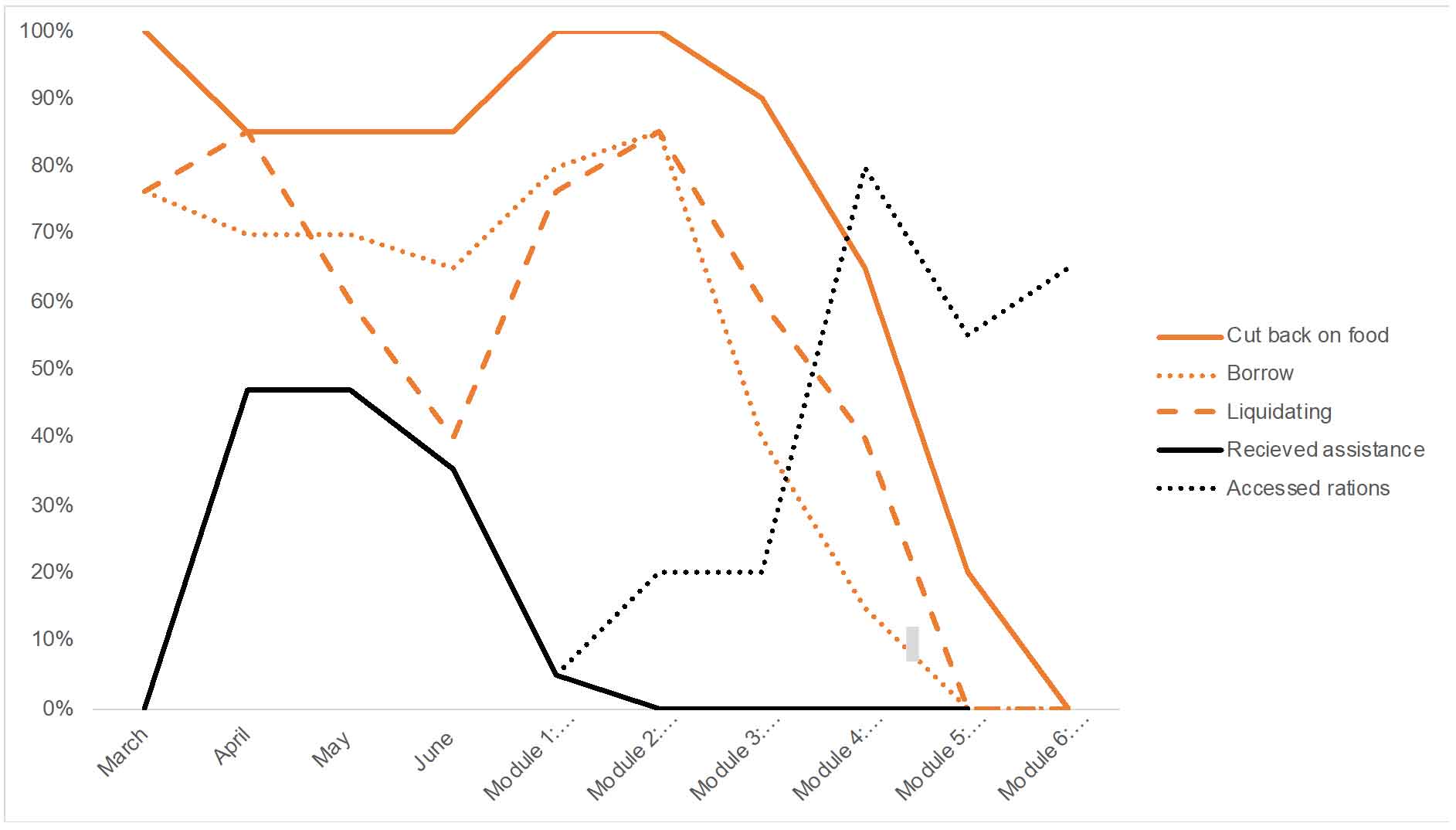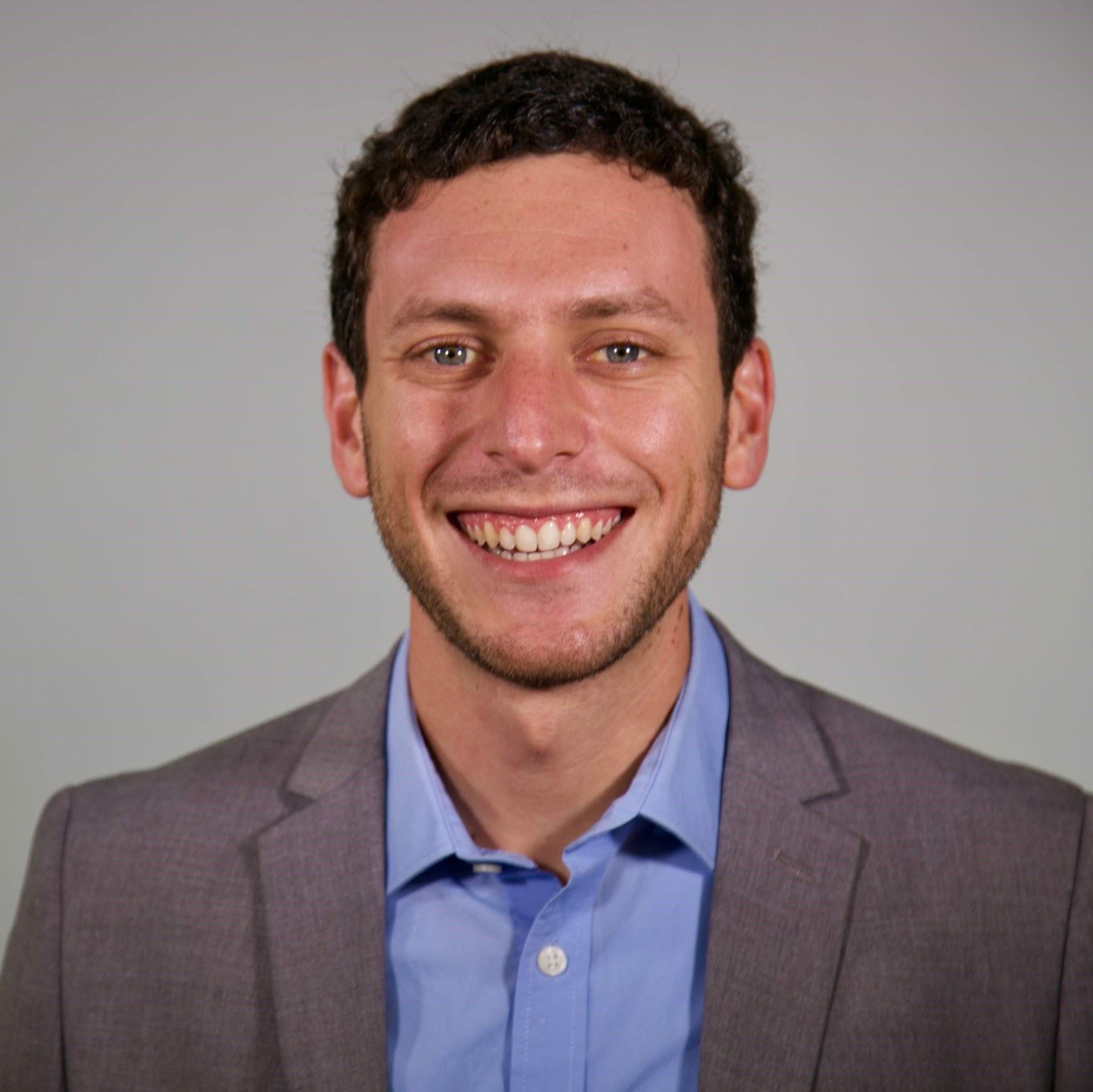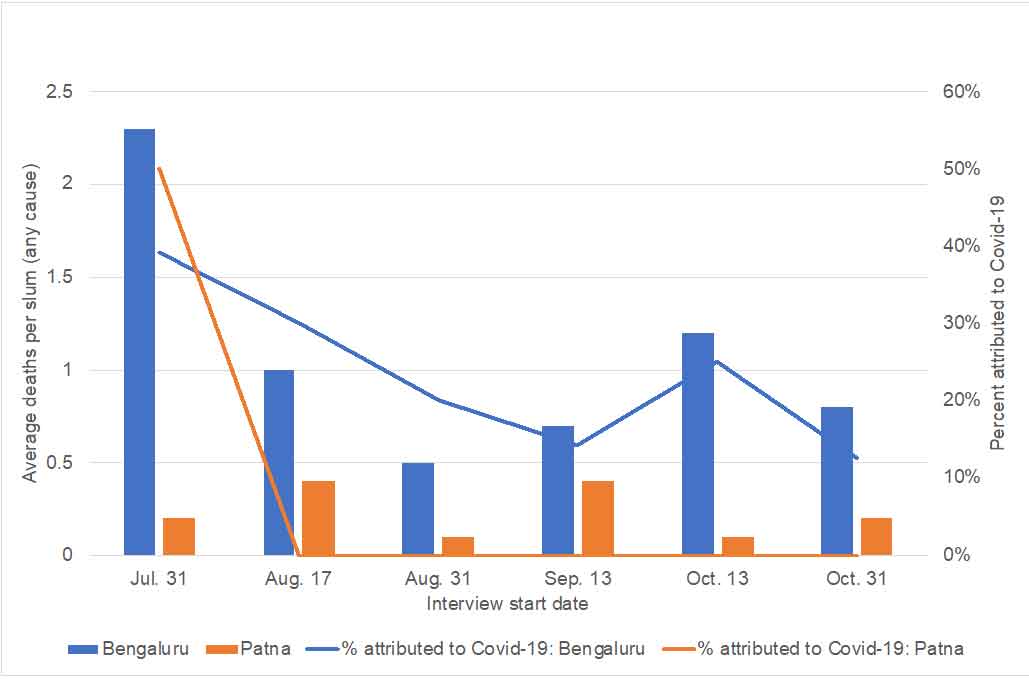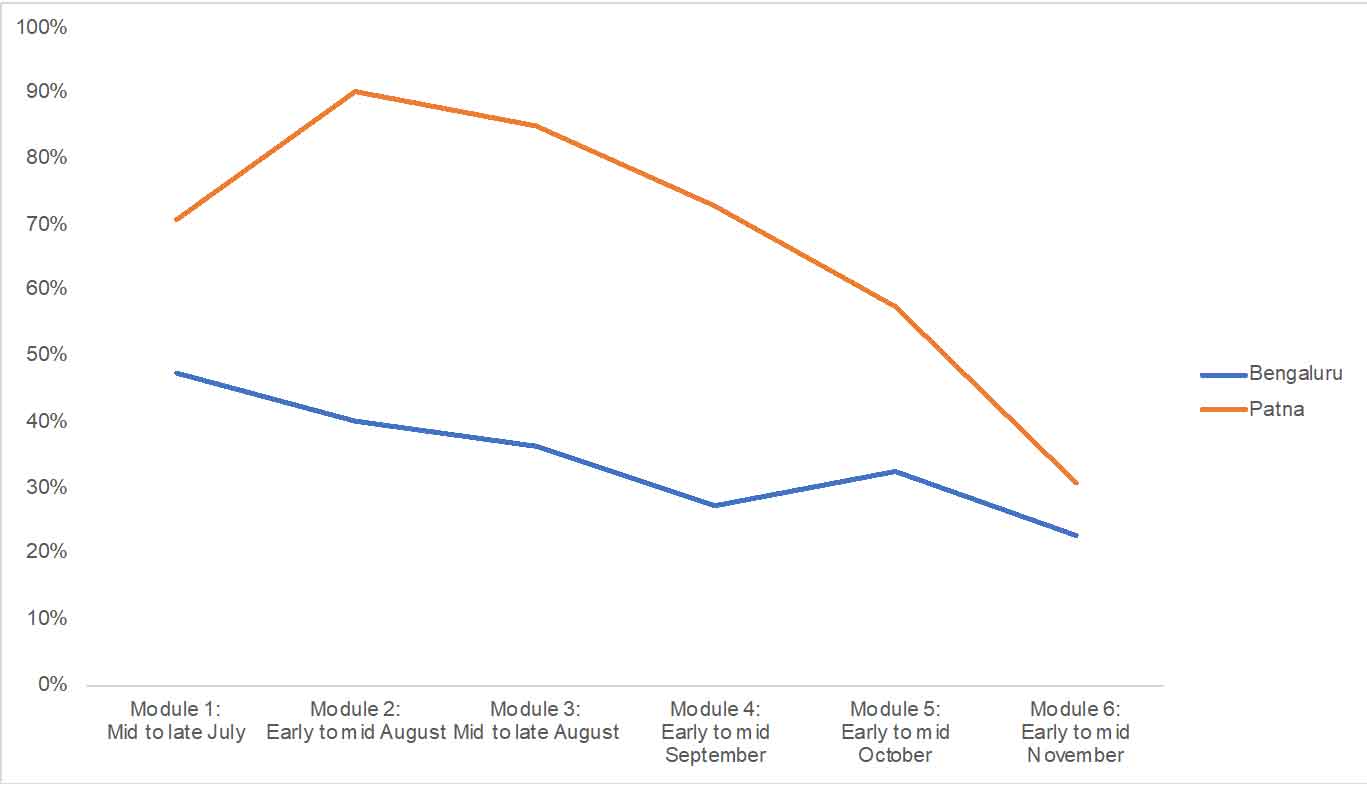Initial predictions suggested that slum communities – densely packed, with shared water taps, and an impossibility of social distancing – would be particularly hard-hit by Covid-19. In this note, Downs-Tepper, Krishna and Rains, use data from surveys in 40 slums across Bengaluru and Patna, to track the health and economic impacts of the pandemic on these vulnerable communities, and to understand the strategies employed by residents to cope with these impacts over time.
Initial predictions by experts suggested that slum communities – densely packed, with shared water taps, and an impossibility of social distancing – would be particularly hard-hit by Covid-19. Furthermore, our own research on slums, conducted over the past decade, underscores how economically vulnerable this population is, with many slum residents living just one illness away from chronic poverty (Krishna 2017, Rains and Krishna 2020).
As part of new IGC research, we seek to track both the health and economic impacts of the pandemic in slums in India, and to understand the strategies that slum residents have drawn on to cope with these impacts over time (Downs-Tepper, Krishna and Rains 2021). We conducted repeated phone interviews with 120 key informants1 in 40 slums – ranging in size from 37 to 3,000 households – in the cities of Bengaluru and Patna during July-November 2020. We selected 20 slums each in the two cities, spanning a wide range of living conditions, and where we have previously conducted representative household surveys. Through phone interviews with key informants approximately every two weeks, we collected a record of near-real-time perceptions of the evolution of the Virus and associated lockdowns in these slum neighbourhoods. We combine these repeated key informant reports with extensive household survey data collected before the pandemic to trace the health and economic effects of the first major wave of the pandemic across neighbourhoods with a wide range of baseline characteristics.
Slums were already vulnerable prior to the pandemic
Many residents of the slum communities we study are entrenched in deep poverty. Our pre-pandemic surveys reveal that nearly all of them were born and raised in the city they still reside in. They work as maids, auto-rickshaw drivers, plumbers, electricians, mobile phone repairmen, vegetable sellers, etc. More than 80% of the respondents in the 40 slums we surveyed have lived there for three or more generations, experiencing little upward mobility. More than half work in the same occupation as their parents.
Further, the vulnerability of residents is compounded by environmental challenges, including overcrowding and inadequate access to water and sanitation. Residents struggle to access official public assistance and basic infrastructure. Despite great need, our surveys show that 40% of slum residents did not have ration cards prior to the pandemic, and only 34% had drinking water connections. Just a little over one-third had completed primary school, and only 6% had jobs with written contracts and statutory benefits. This precarity was before the pandemic touched India’s shores.
Slum communities were (initially) spared the worst-case infection fears
A silver lining accompanied the negative health effects from the first major wave of the pandemic. Early on, experts predicted a dire picture in developing countries, with high anticipated mortality rates due to poor health systems and population risk factors. Contrary to these expectations, our study found almost no reported deaths in examined slum communities in Patna, and a few deaths – clustered in just six slums – in Bengaluru (Figure 1). Instances of severe infection requiring hospitalisation were similarly scarce. Our findings are consistent with India’s public reporting of lower rates of severe infection during the first wave relative to other countries, even though the Virus appears to have spread widely (Mohanan et al. 2021). Several potential explanations about disease spread fail to explain these inter- and intra-city differences. While some have speculated that differences in population age, or climate explain differences in disease incidence, neither resident age nor weather vary substantially across the cities (Nordling 2020, Mecenas et al. 2020). We also found no significant association between these Covid-19 clusters and a range of predictors: use of shared amenities like toilets or water pumps, the number of households in the slum, proximity to city centre or each other, or resident demographics.
Figure 1. Deaths reported by key informants (total and percent attributed to Covid-19), by city (average per slum)
Pandemic-related shutdowns have devastated vulnerable communities in both cities
However, the good news from the first wave in terms of health does not extend to the economic picture – in both cities, respondents described severe and persistent shocks to their livelihoods resulting from the economic lockdowns. The livelihoods shock was sudden: in the first month after the Covid-19 lockdown began, our key informants estimate that roughly half of household heads in Bengaluru, and more than 80% in Patna, had lost their primary source of income. The shock was also long-lasting: by November, one-quarter of pre-pandemic income in Bengaluru and one-third in Patna had still not been recovered (Figure 2). Respondents reported fewer days worked and lower wage rates per day than prior to the pandemic.
Figure 2. Approximate percentage of pre-pandemic income not recovered, by city
At the same time as households’ income fell – in some cases – expenditures increased. The conversion of government hospitals to Covid-19 treatment wards meant that only expensive private hospitals were available to address residents’ non-Covid medical needs. Some suspected Covid-19 cases, necessitating testing, which led to steep bills, approaching the equivalent of two months’ salary in an instance when quarantine was required. Suspension of public transport shifted a substantial cost burden to individuals, requiring them to arrange private transportation or forego employment. To cope, residents cut back on food, sold valuables, and borrowed money (Figure 3, focussed on Patna). Indeed, we found that the already severe effects were yet worse in areas which were most vulnerable. For example, in areas where residents had lower levels of pre-pandemic savings, families cut back on food more than in neighbourhoods with higher pre-pandemic savings levels.
Figure 3. Coping behaviour and assistance in Patna over time

Note: Figure shows the percentage of Patna neighbourhoods with at least 10% of residents reporting cutting back on food, borrowing, etc.
Importance of policy support for India’s slums
While the pandemic has exacerbated existing vulnerability, the fragility of slums long predates Covid-19. Policy intervention must come – in a quick and sustained manner – to alleviate suffering, especially now in response to the recent onset of the newest major wave. In the immediate term, slum residents – who have spent down their small savings, liquidated meagre assets, and taken on loans – require immediate and regular assistance to forestall the descent into deeper poverty once debts come due.
Over the longer term, preventing similar future crises necessitates the same institutional support, which we know helps people avert risks. These include workplace protections, health insurance, and old-age support. In addition to these forms of social assistance, investments must be made to help people help themselves – through education, skills training, and entrepreneurship. Covid-19 and its associated lockdowns were, and are, a crisis – but they are also a demonstration of the existing vulnerability which policy must address.
I4I is now on Telegram. Please click here (@Ideas4India) to subscribe to our channel for quick updates on our content.
Note:
- Key informants are those who were named as area leaders and/or as particularly knowledgeable about their communities by their neighbours during our pre-pandemic surveys.
Further Reading
- Downs-Tepper, H, A Krishna and E Rains (2021), ‘Covid-19 in slum communities of Patna and Bengaluru’, IGC Policy Brief.
- Krishna, A (2017), The Broken Ladder: The Paradox and Potential of India’s One-Billion, Cambridge University Press.
- Mohanan, Manoj, Anup Malani, Kaushik Krishnan and Anu Acharya (2021), “Prevalence of SARS-CoV-2 in Karnataka, India”, JAMA, 325(10):1001-1003.
- Mecenas, Paulo, Renata Travassos da Rosa Moreira Bastos, Antonio Carlos Rosário Vallinoto and David Normando (2020), "Effects of temperature and humidity on the spread of COVID-19: A systematic review", PLOS ONE, 15(6): e0238339.
- Nordling, Linda (2020), "Africa's pandemic puzzle: why so few cases and deaths?", Science, 369(6505): 756-757.
- Rains, Emily and Anirudh Krishna (2020), "Precarious gains: social mobility and volatility in urban slums" World Development, 132: 105001. Available here.




 31 May, 2021
31 May, 2021 








By: Pragati Verma 31 May, 2021
very helpful article